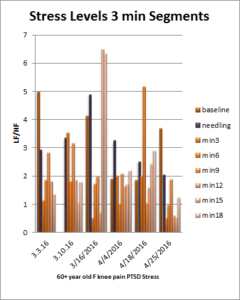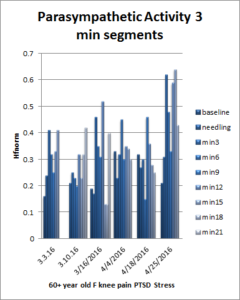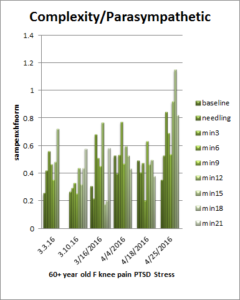Knee Pain, PTSD, Stress: Clinical Case Study
Kristen Sparrow • April 26, 2016

This story is probably not over but illustrates a few different issues I’m tackling. This patient is well over 60, in a competitive high powered job. She has had health issues over time, accidents and trauma in particular. She came in because of knee pain, but it was clear that there were system issues, too. On exam, from a TCM standpoint, she had heart/kidney rupture. Because there are protocols for PTSD that use scalp needles I did sishencong and 23,24 DM. But I wasn’t seeing much to my liking. So yesterday I switched to a purely yin treatment treating the heart/kidney rupture, no scalp needles. In spite of the heavy, intense stress she’s been under the last two weeks, I finally got some beautiful data. The pain in her knee has lessened considerably too.
 This is her overall autonomic balance, her sympathetic/parasympathetic LF/HF. The lower the numbers the better for this measurement. Yesterday, she finally got the nice High/Low (the dramatic plunge after needling) and an overall relaxation response after needling.
This is her overall autonomic balance, her sympathetic/parasympathetic LF/HF. The lower the numbers the better for this measurement. Yesterday, she finally got the nice High/Low (the dramatic plunge after needling) and an overall relaxation response after needling.
 This is her parasympathetic only. Here, we want to see higher numbers. Notice the dramatic uptrend yesterday. Nice.
This is her parasympathetic only. Here, we want to see higher numbers. Notice the dramatic uptrend yesterday. Nice.
This is the measure that in uniquely mine. I combine complexity with parasympathetic activity. Here the higher the numbers the better. This can give added information in certain patients. Again the uptick is remarkable.
She may have just needed time to get this “healing shift.” But it could be the result of needling strategies. And, of course, it could have been a fluke, so we will see.
The challenge is to be able to identify that kind of effective strategy earlier, if possible.


